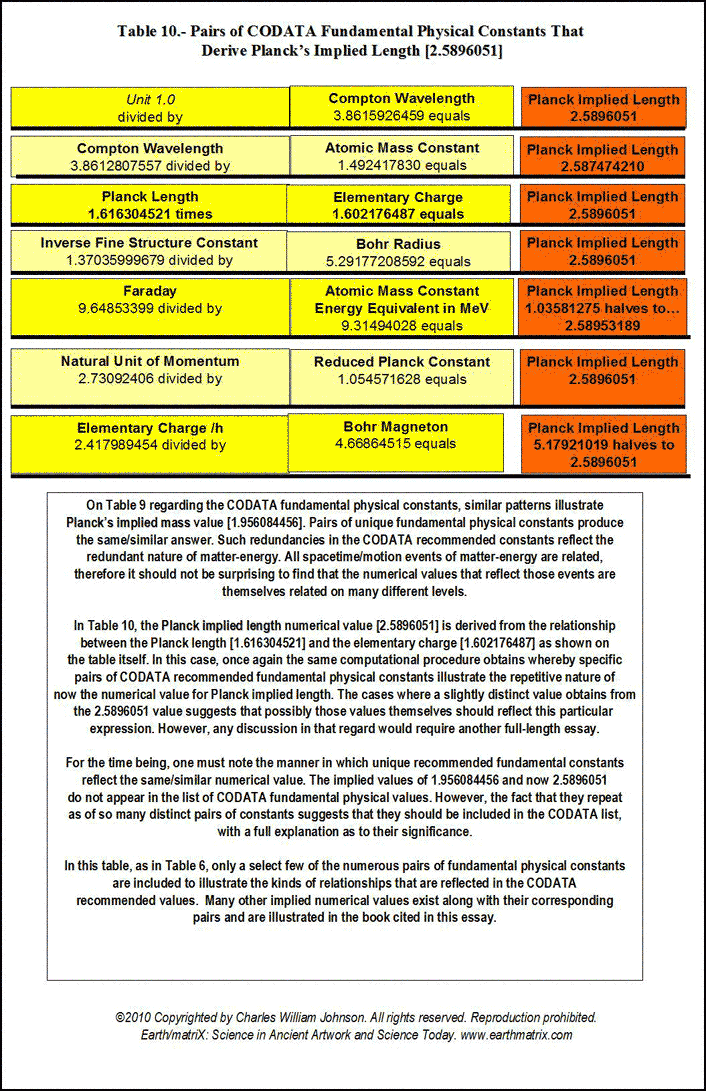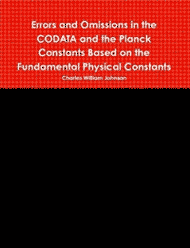
Dedicated to the preservation of human knowledge in the arts and sciences,
and to the advancement of human survival and to that of our planet in a world threatened by our own development.
|
|
|
Relationships Regarding Select
Fundamental by Charles William Johnson In this essay, interrelationships of selected fundamental physical and chemical constants are examined as of the CODATA recommended values, as well as of the implied Earth/matriX values. The propositons regarding the analysis of interrelationships of select physical and chemical constants is presented in the order in which they appear in one of my notebooks. Numerical values are presented in their fractal expression with a floating decimal place. Numerical values vary according to certain computational procedures, but in general the first five significant digits determine the relevancy of the computation. 1.- The von Klitzing constant is a derivative of a 1.366c numerical value. For an extended list of physical and chemical constants reflecting a 1.366c numerical value, visit www.earthmatrix.com. 2.5812807557 halves down to 1.366518783. 2.- The Compton wavelength is a reciprocal of the Planck implied length. 1 / 3.8615926459 = 2.5896051 3.- Planck length times the elementary charge yields Planck implied length. 1.616304 times 1.602176487 = 2.589604265 4.- The natural unit of energy in MeV is the reciprocal of the Planck implied energy. 1 / 5.10998910 = 1.956951337 5.- Inverse fine structure constant divided by Bohr radius yields Planck implied length. 1.37035999679 / 5.2917720859 = 2.589605096 6.- The reciprocal of the atomic unit of magnetic dipole moment is Planck mass. 1 / 1.854801830 = 5.39141155 7.- The reciprocal of the atomic unit of permittivity is the square value of the speed of light in vacuo. 1 / 1.112650056 = 8.987551789 8.- The neutron mass and the mass of the electron are near fractal reciprocals. 1.674927211 doubles to 1.372100371 9.10938215 doubles to 7.28750572 whose reciprocal is 1.3722116 9.- The Planck mass times the Rydberg constant yields mass defect. 2.17644 times 1.0973731568527 = 2.388366832. 10.- The reciprocal of the magnetic flux quantum is the conventional value of the Josephson constant. 1 / 2.067833667 = 4.83597891 11.- Half of the fractal numerical value of the conventional value of the Josephson constant is the elementary charge as e/h. 4.83597891 / 2 = 2.417989454 12.- The elementary charge divided by Planck's constant is the elementary charge as e/h. 1.602176487 / 6.62606896 = 2.417989454 13.- The reciprocal of the magnetic flux quantum divided by the elementary charge yields fractal inverse of conductance quantum. 2.067833667 / 1.602176487 = 1.29064037787 14.- Revised computation. The reciprocal of Planck time yields a distinct value for the atomic unit of magnetic dipole moment, which in turn yields a distinct value for the Bohr magneton. In this sense the derivative of Planck time contradicts the numerical value for the Bohr magneton. 1 / 5.39124 = 1.85486085 / = 9.2743042. 15.- The revised Bohr magneton value divided by the elementary charge yields a distinct fractal value for the Bohr magneton in eV T-1. 9.2743042 / 1.602176487 = 5.788565913 16.- The elementary charge divided by the conventional value of the Josephson constant yields half the value of the Planck constant. 1.602176487 / 4.83597891 = 3.313034479 doubles to 6.62606896 17.- The conventional value of the Josephson constant divided by the inverse conductance quantum yields a near fractal value of the speed of light in vacuo. Variations in the value call for theoretical consideration of terms. 4.83597891 / 1.29064037787 = 3.746960808 doubles to.2.997568647. 18.- There are about thirty pairs of fundamental physical constants in the CODATA that produce the fractal numerical value of the elementary charge. Here are a few relevant examples of many. The magnetic flux quantum times the conductance quantum yields the elementary charge. 2.067833667 times 7.7480917004 = 1.602176487 The magnetic flux quantum divided by the elementary charge yields the inverse conductance quantum. 2.067833667 divided by 1.602176487 = 1.29064037787 The conductance quantum divided by the elementary charge yields the conventional value of the Josephson constant. 7.7480917004 / 1.602176487 = 4.83597891 With the previous three examples, one should begin to get the feel for how the recommended fundamental physical constants are interrelated as of their fractal numerical values. For even though each constant, with its own proper name, appears to be self-sustaining and significant, actually obtains its meaning from the interrelationship with the other fundamental physical constants. 19.- This proposition should have headed the list presented here, but the purpose is to follow the flow of the notebook and how the numbers derived thereof. The elementary charge is a near fractal multiple expression of Planck's constant. From this perspective, one may understand how so many interrelationships appear regarding the elementary charge as a function of Planck's constant, or vice versa. 1.602176487 halves to 6.62644664 6.62606896 doubles to 1.60208577 20.- The electron charge to mass quotient divided by pi yields a fractal multiple expression of the Bohr magneton in eV t-1 / h. 1.758820150 / 3.141592654 = 5.59849842 halves to 1.3996246 21.- The proton-electron mass ratio divided by the Planck implied energy yields a near multiple expression of the proton mass energy equivalent in MeV [938.272013]. 1.83615267247 / 1.956084456 = 9.38687829 Inversely: 1.83615267247 / 9.38272013 = 1.956951339 The proton mass energy equivalent in MeV divided by the Planck implied energy value yields a near fractal multiple of the speed of light in vacuo. 9.38272013 / 1.956084456 = 4.796684571 halves to.2.997927857 22.- The neutron-electron mass ratio divided by the neutron mass energy equivalent in MeV yields a near fractal multiple of Planck's implied energy. The order in this selection is inverted simply for the sake of flexibility in the analysis of the interrelationships. In other words, there is no specific order to be followed in discerning the interrelationships. 1.8386836605 / 9.39565346 = 1.956551337 The significant point in the analysis is to recognize the meaning of the Planck implied values and their need to be taken into consideration in the CODATA listing of recommended values. In other words, the Planck implied values are not merely computational in nature but represent constant relationships within spacetime/motion and the specific expressions of matter-energy. 23.- The elementary charge divided by the Planck implied energy yields an inverse fractal expression of Planck energy, whose reciprocal is Planck energy of course. 1.602176487 / 1.956084456 = 8.19073267 whose reciprocal is 1.220892. The inverse Planck energy, 8.19073267, doubles to 6.552586136, reflective of Planck's second choice for the value of his constant [6.55] forwarded by him in 1900. 24.- Planck mass times Planck implied energy yields near fractal multiple of the [shielded] proton gyromagnetic ratio /pi [4.25774821; 4.25763881]. 2.17644 times 1.956084456 = 4.257300453. 25.- The [shielded] proton gyromagnetic ratio divided by the Planck implied energy yields a near fractal multiple of the Newtonian constant of gravitation [6.67428]. 2.67515336 / 1.956084456 = 1.367606268 halves to 6.67776 One cannot help but notice the particular relevancy of the Fermi coupling constant [2.2255] to the Newtonian constant of gravitation: 6.67428 / 3 = 2.22476 2.2255 x 3 = 6.6765 26.- The reciprocal of the square of the speed of light in vacuo yields a near fractal multiple of the Fermi coupling constant [2.2255]. 1 / 8.987551787 = 1.11265056 doubles to 2.2253001 27.- Interrelationships for Planck implied length are presented in the following table. Once again, the examples presented on the following table that illustrate how specific pairs of fundamental physical constants derive the Planck implied length are only a few of many. Such are the relationships of redundancy among the CODATA recommended fundamental physical constants that numerous tables would be needed to illustrate each particular implied fractal value. In various essays and in one of my recent books about the Planck constants, I have presented numerous examples of the Planck implied values that do not appear in the CODATA listing. In my view, these particular relationships and implied fractal values need to be incorporated into the CODATA listing along with a detailed theoretical explanation as to their derivation and meaning with regard to all of the other fundamental physical constants.
28.- The fine structure constant represents a near fractal reciprocal multiple of the elementary charge [1.602176487]. 7.2973525376 halves to. 6.241314033 whose reciprocal is 1.602226702. Equally interesting is that the fine structure constant halves to 6.636903. 29.- The natural unit of time multiplied by the Planck implied time yields a near fractal multiple of the atomic unit of permittivity [1.11265056]. 1.288088657 times 8.637717964 = 1.112614653. Check my previous essay and book on Planck implied values, as in Planck time 5.39124 times the elementary charge, 1.602176487, equals the Planck implied time: 8.637717964. With the previous list, it should be apparent by now that the Planck implied values are not randomly coincidental, but reflect relationships of spacetime/motion in specific forms of matter-energy. From this list, it also becomes evident that one may not only base the derivation of the Planck constants on the fundamental physical constants, but do likewise regarding many of the other recommended CODATA values. Note that the many diverse interrelationships of the fundamental physical constants and the Planck constants are carried out with basic math. Given the fact that all of spacetime/motion is relational, and that all forms of matter-energy are relational, it is possible to derive all of the fundamental physical constants in the manner illustrated in this brief selective summary. At least, this is the case when the fundamental physical constants reflect exact and precise measurements. ©2010 Copyrighted by Charles William Johnson. All rights reserved. Reproduction prohibited. Earth/matriX Editions,
|




